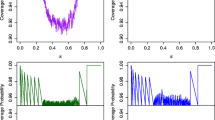Abstract
Response-adaptive designs may be used in phase III clinical trials to allocate a larger number of patients to the better treatment. Optimal response-adaptive designs are used for the same purpose, but the design is derived from some optimal points of view. The available optimal response-adaptive designs are only for two treatment trials. In the present paper, we extend this idea and derive some optimal response-adaptive designs for phase III clinical trials for more than two treatments. In particular, we work on three treatments. The extension is not trivial, as the designs for three treatments are often iterative, and they need specific algorithms for computation. The proposed approaches are numerically illustrated.
Access this chapter
Tax calculation will be finalised at checkout
Purchases are for personal use only
Preview
Unable to display preview. Download preview PDF.
Similar content being viewed by others
References
Bartlett R, Roloff D, Cornell R, Andrews A, Dillon P, Zwischenberger J (1985) Extracorporeal circulation in neonatal respiratory failure: a prospective randomized trial. Pediatrics 76:479–487
Biswas A, Dewanji A (2004) Inference for a rpw-type clinical trial with repeated monitoring for the treatment of rheumatoid arthritis. Biometrical Journal 46:769–779
Durham S, Flournoy N, Li W (1998) A sequential design for maximizing the probability of a favorable response. Canadian Journal of Statistics 26:479–495
Hayre L (1979) Two-population sequential tests with three hypotheses. Biometrika 66:465–474
Ivanova A (2003) A play-the-winner type urn model with reduced variability. Metrika 58:1–13
Ivanova A, Rosenberger W, Durham S, Flournoy N (2000) A birth and death urn for randomized clinical trials: asymptotic methods. Sankhya B 62:104–118
Jennison C, Turnbull B (2000) Group Sequential Methods with Applications to Clinical Trials. Chapman and Hall/CRC, Boca Raton, Florida
Rosenberger W, Lachin J (2002) Randomization in Clinical Trials: Theory and Practice. Wiley, New York
Rosenberger W, Stallard N, Ivanova A, Harper C, Ricks M (2001) Optimal adaptive designs for binary response trials. Biometrics 57:173–177
Rout C, Rocke D, Levin J, Gouw’s E, Reddy D (1993) A reevaluation of the role of crystalloid preload in the prevention of hypotension associated with spinal anesthesia for elective cesarean section. Anesthesiology 79:262–269
Scarborough J (1966) Numerical Mathematical Analysis, Sixth edition. Oxford and IBH Publishing Co. Pvt. Ltd., New Delhi
Tamura R, Faries D, Andersen J, Heiligenstein J (1994) A case study of an adaptive clinical trial in the treatment of out-patients with depressive disorder. Journal of the American Statistical Association 89:768–776
Wei L (1979) The generalized polya’s urn design for sequential medical trials. Annals of Statistics 7:291–296
Wei L, Durham S (1978) The randomized play-the-winner rule in medical trials. Journal of the American Statistical Association 73:840–843
Zelen M (1969) Play the winner rule and the controlled clinical trial. Journal of the American Statistical Association 64:131–146
Author information
Authors and Affiliations
Editor information
Editors and Affiliations
Rights and permissions
Copyright information
© 2007 Physica-Verlag Heidelberg
About this paper
Cite this paper
Biswas, A., Mandal, S. (2007). Optimal Three-Treatment Response-Adaptive Designs for Phase III Clinical Trials with Binary Responses. In: López-Fidalgo, J., Rodríguez-Díaz, J.M., Torsney, B. (eds) mODa 8 - Advances in Model-Oriented Design and Analysis. Contributions to Statistics. Physica-Verlag HD. https://doi.org/10.1007/978-3-7908-1952-6_5
Download citation
DOI: https://doi.org/10.1007/978-3-7908-1952-6_5
Publisher Name: Physica-Verlag HD
Print ISBN: 978-3-7908-1951-9
Online ISBN: 978-3-7908-1952-6
eBook Packages: Mathematics and StatisticsMathematics and Statistics (R0)




